I Just Knew That My Inherent Mistrust Of AI Would Save Me Someday
I just knew that my inherent mistrust of AI would save me someday




This robot led people to their doom — and they still followed it
Researchers from Georgia Tech, backed by money from the Air Force, ran a test to see if people trying to escape from a high-rise building would trust a robot to lead them. Overwhelmingly, the sheeple followed the little droid to their simulated deaths. In the video, the researchers theorize why people obliged.
Follow @the-future-now
More Posts from Secretagentpeptidebond and Others
Mitochondria is the powerhouse of the cell
my graduate school professor
Yes, even in graduate school, we are still being told this
(via misbehavedscientist)



In ‘Wild Design,’ Vintage Illustrations Expose the Patterns and Shapes Behind All Life on Earth
Exploring an Asteroid Without Leaving Earth

You may remember that back in February, four crew members lived and worked inside our Human Research Exploration Analog (HERA). That crew, made up of 4 women, simulated a 715-day journey to a Near-Earth asteroid. That 30 day mission helped our researchers learn how isolation and close quarters affect individual and group behavior. Studies like this at our Johnson Space Center prepare us for long duration space missions, like a trip to an asteroid or even to Mars.
We now have another crew, made up of four men, living and working inside the HERA. This is the spacecraft’s 10th crew. The mission began on May 3, and will end on June 1.

The crew members are currently living inside this compact, science-making house. But unlike in a normal house, these inhabitants won’t go outside for 30 days. Their communication with the rest of planet Earth will also be very limited, and they won’t have any access to internet. The only people they will talk with regularly are mission control and each other.

The HERA X crew is made up of four males selected from the Johnson Space Center Test Subject Screening (TSS) pool. The crew member selection process is based on a number of criteria, including the same criteria for astronaut selection. The four would-be astronauts are:
Ron Franco
Oscar Mathews
Chris Matty
Casey Stedman
Lisa Spence, the Human Research Program’s Flight Analogs Project Manager, explained that ideally they would like the four-person crews to be two males and two females. Due to the applicant pool, HERA IX was an all female crew, and HERA X (this current mission) is all male.

What will they be doing?
The crew will test hardware prototypes to get “the bugs worked out” before they are used in off-Earth missions. They will conduct experiments involving plants, brine shrimp, and creating a pice of equipment with a 3D printer. After their visit to an asteroid, the crew will simulate the processing of soil and rocks they collected virtually. Researchers outside of the spacecraft will collect data regarding team dynamics, conflict resolution and the effects of extended isolation and confinement.

How real is a HERA mission?
When we set up an analog research investigation, we try to mimic as many of the spaceflight conditions as we can. This simulation means that even when communicating with mission control, there will be a delay on all communications ranging from 1 to 5 minutes each way, depending on how far their simulated spacecraft is from Earth.
Obviously we are not in microgravity, so none of the effects of microgravity on the human or the vehicle can be tested. You can mimic isolation to some degree – although the crew knows they are note really isolated from humanity, the communications delays and ban from social media help them to suspend reality. We mimic confinement and the stress that goes along with it.
Scientists and researchers use analogs like HERA to gather more data for comparison to data collected aboard the space station and from other analogs so they can draw conclusions needed for a real mission to deep space, and one day for a journey to Mars.

A few other details:
The crew follows a timeline that is similar to one used for the ISS crew.
They work 16 hours a day, Monday through Friday. This includes time for daily planning, conferences, meals and exercises.
They will be growing and taking care of plants and brine shrimp, which they will analyze and document.
Past HERA crew members wore a sensor that recorded heart rate, distance, motion and sound intensity. When crew members were working together, the sensor would also record their proximity as well, helping investigators learn about team cohesion.
Researchers also learned about how crew members react to stress by recording and analyzing verbal interactions and by analyzing “markers” in blood and saliva samples.
In total, this mission will include 22 individual investigations across key human research elements. From psychological to physiological experiments, the crew members will help prepare us for future missions.

Want a full, 360 degree look at HERA? Check out and explore the inside of the habitat.
For more information on our Human Research Program, visit: www.nasa.gov/hrp.
Make sure to follow us on Tumblr for your regular dose of space: http://nasa.tumblr.com
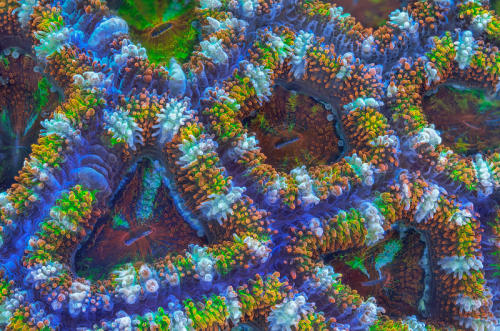

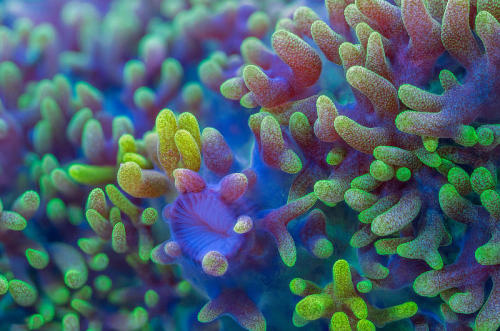
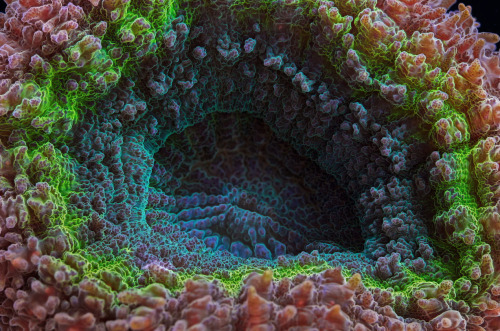

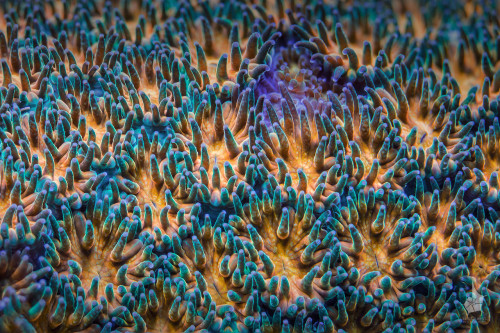
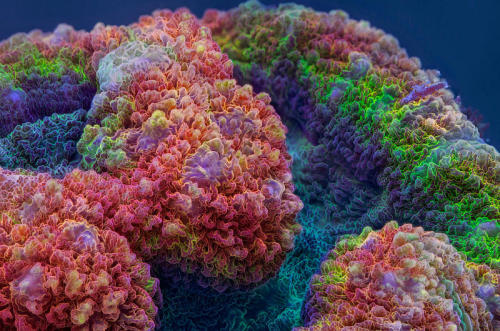
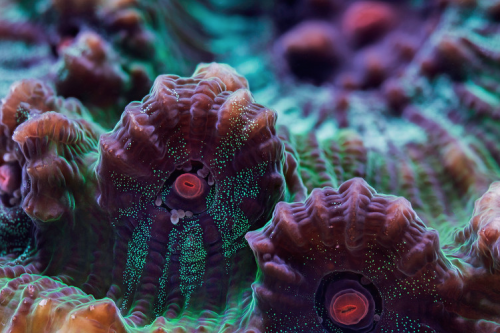
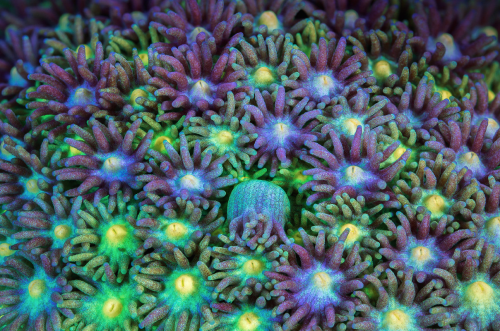

daniel stoupin, a doctoral candidate in marine biology at the university of queensland, has photographed a variety of coral species from the great barrier reef using full spectrum light to reveal fluorescent pigments that would otherwise be invisible to the naked eye. (see more at bioquest studios)
coral growth rates in the great barrier reef have plummeted 40 percent in the last 40 years, a result, according to a recent study, of increased ocean acidification. since the beginning of the industrial revolution, about one third of the carbon dioxide that has been released into the atmosphere as a result of fossil fuels has been absorbed by the oceans, where it in turn prevents coral from using a mineral called aragonite to make their calcified skeletons.
new modelling has also shown that if ocean waters continue to warm by even one degree, which most now see as unstoppable, the coverage of corals on the great barrier reef could decline to less than 10 percent, which is a level too low for the reef to mount a recovery.
further complicating matters for the coral is the plastic detritus left by humans which now litter the oceans and which the coral now consume. unable to expel the plastic bits and thus take in nutrients, the coral slowly starve. a recent study found that each square kilometre of australia’s sea surface water is contaminated with approximately 4,000 pieces of tiny plastic.

Finally! Something was made what is a critical compound during the production of a quite special amino acid.
The fun part with this was, that I tried nearly 20 methods to obtain this compound, and all of them failed. At last I tried a Chinese recipe what said that the product will be something that could be easily converted to my molecule, but instead of that compound I got the compound what I need out from the reaction. Better news: 90% isolated yield!
Ooh, I love fluorescent compounds! It's a great reward for the long process of synthesis.


How incredible is this compound I made??! It’s an NBD amine, which is fluorescent and used for labeling compounds for fluorescence assays.
-
 no-more-the-sub-mariner reblogged this · 8 years ago
no-more-the-sub-mariner reblogged this · 8 years ago -
 flamingbananacat liked this · 8 years ago
flamingbananacat liked this · 8 years ago -
 youre-you-i-am-me reblogged this · 8 years ago
youre-you-i-am-me reblogged this · 8 years ago -
 ataehone liked this · 9 years ago
ataehone liked this · 9 years ago -
 krizpeekreem reblogged this · 9 years ago
krizpeekreem reblogged this · 9 years ago -
 the-porcelain-flower reblogged this · 9 years ago
the-porcelain-flower reblogged this · 9 years ago -
 meog1120 reblogged this · 9 years ago
meog1120 reblogged this · 9 years ago -
 benjo-kauzooie reblogged this · 9 years ago
benjo-kauzooie reblogged this · 9 years ago -
 slvvvg reblogged this · 9 years ago
slvvvg reblogged this · 9 years ago -
 slvvvg liked this · 9 years ago
slvvvg liked this · 9 years ago -
 fjorrd liked this · 9 years ago
fjorrd liked this · 9 years ago -
 grouchydonut reblogged this · 9 years ago
grouchydonut reblogged this · 9 years ago -
 thedapperdarth reblogged this · 9 years ago
thedapperdarth reblogged this · 9 years ago -
 thedapperdarth liked this · 9 years ago
thedapperdarth liked this · 9 years ago -
 sweetsonautica liked this · 9 years ago
sweetsonautica liked this · 9 years ago -
 sweetsonautica reblogged this · 9 years ago
sweetsonautica reblogged this · 9 years ago -
 shadowofveils reblogged this · 9 years ago
shadowofveils reblogged this · 9 years ago -
 cool77778 liked this · 9 years ago
cool77778 liked this · 9 years ago -
 jeffnaga liked this · 9 years ago
jeffnaga liked this · 9 years ago -
 huffly-puffs reblogged this · 9 years ago
huffly-puffs reblogged this · 9 years ago -
 huffly-puffs liked this · 9 years ago
huffly-puffs liked this · 9 years ago -
 coilsoftheuniverse reblogged this · 9 years ago
coilsoftheuniverse reblogged this · 9 years ago -
 amixofitall reblogged this · 9 years ago
amixofitall reblogged this · 9 years ago -
 pomato-queendom reblogged this · 9 years ago
pomato-queendom reblogged this · 9 years ago -
 jourrii reblogged this · 9 years ago
jourrii reblogged this · 9 years ago -
 ageneralruckus liked this · 9 years ago
ageneralruckus liked this · 9 years ago -
 b1ackb3rryw1n3aunt reblogged this · 9 years ago
b1ackb3rryw1n3aunt reblogged this · 9 years ago -
 b1ackb3rryw1n3aunt liked this · 9 years ago
b1ackb3rryw1n3aunt liked this · 9 years ago -
 stateofgrace liked this · 9 years ago
stateofgrace liked this · 9 years ago -
 tenkotoshiggy reblogged this · 9 years ago
tenkotoshiggy reblogged this · 9 years ago -
 tenkotoshiggy liked this · 9 years ago
tenkotoshiggy liked this · 9 years ago -
 alexzefox liked this · 9 years ago
alexzefox liked this · 9 years ago -
 toruhsnape liked this · 9 years ago
toruhsnape liked this · 9 years ago -
 rhaenatargayryen reblogged this · 9 years ago
rhaenatargayryen reblogged this · 9 years ago -
 lumalees reblogged this · 9 years ago
lumalees reblogged this · 9 years ago -
 bigdumbscorpianwife reblogged this · 9 years ago
bigdumbscorpianwife reblogged this · 9 years ago -
 bigdumbscorpianwife liked this · 9 years ago
bigdumbscorpianwife liked this · 9 years ago












